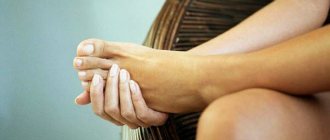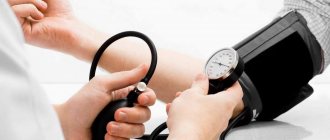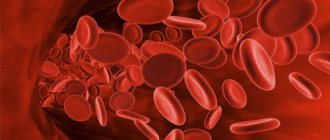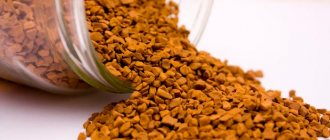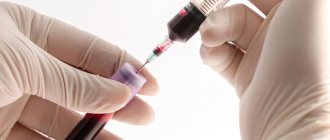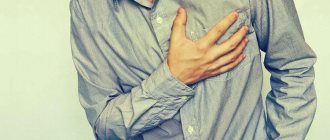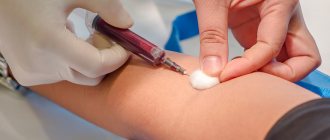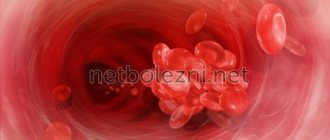How to normalize poor blood circulation in the legs
Blood is one of the main components of the human body. It moves all vital substances throughout the body. Additionally, the blood removes toxic components from the body. Circulatory disorders can occur spontaneously. However, this is always a bad sign that needs to be addressed. Poor blood circulation negatively affects the entire body. Poor blood circulation in the legs can lead to discomfort in the heart, dizziness, loss of strength, partial memory loss and some other problems.
For what reasons is blood circulation in the legs impaired?
Poor circulation in the legs can be the result of existing health problems or factors that negatively affect the body's performance. The main root causes that have a bad effect on blood flow are smoking, alcohol abuse, drinking large amounts of coffee, poor diet, and a sedentary lifestyle.
Doctors also identify the following causes of blood flow disorders:
- pregnancy in women;
- development of complications against the background of existing diseases;
- presence of diabetes mellitus;
- poor nutrition;
- high cholesterol and thyroid disease;
- hypertension and heart disorders;
- sudden weight gain and heart problems;
- eating disorders.
This is only a small part of the factors that can lead to blood flow disorders. It is in the legs that circulation worsens most often due to existing atherosclerosis, endarteritis, diabetes mellitus, and thrombophlebitis.
How to recognize poor circulation by symptoms
Deterioration in blood circulation can be recognized by the symptoms present. Pay attention to the sensations as you walk. When blood flow deteriorates, minor pain occurs. This is a sign indicating serious problems with the arteries. Intermittent claudication occurs.
Painful sensations appear in different parts of the leg. Sometimes discomfort can even affect the lumbar region. Numbness occurs in the limbs. Additionally, weakness appears in the legs.
Impaired blood flow in the legs can be recognized by the severity that arises. In addition, cramps constantly bother me. Only in rare cases does the deviation occur without extraneous signs.
If you have all of the above symptoms, you should seek help from a doctor as soon as possible. Sometimes blood circulation is a secondary sign indicating more serious health problems.
Useful tips for restoring blood circulation
In the initial stages, when the disorder is not associated with other pathologies, blood circulation can be easily restored on its own. Recommended:
- Stop smoking. It is this addiction that leads to disruption of blood flow more often than others. Nicotine and oxygen oxide have a bad effect on blood circulation.
- Stop drinking alcohol. It is alcohol that prevents the endothelium and smooth muscles from controlling blood flow.
- Normalize weight. Excess body weight not only impairs blood flow, but also several times increases the likelihood of developing various diseases of the heart and vascular system.
- Give preference to an active lifestyle. Inactivity always negatively affects blood flow. It is recommended to do exercises or take walks daily.
- Eat properly. Much also depends on diet. Vitamin C is important for blood circulation. It is necessary to include in the menu as many products as possible that contain it. You need to exclude all unhealthy foods from your diet - fatty, fried, floury, etc.
You cannot do without standard treatment. If you have problems with blood circulation in your legs, visit a doctor. After a comprehensive diagnosis, the doctor will select the appropriate treatment that will help eliminate the problem as soon as possible.
Breathing exercises and exercises
There are many breathing exercises and exercises that have a beneficial effect on blood oxygen saturation. Yoga and other eastern gymnastic systems offer such exercises. As a rule, during such exercises the patient’s well-being improves due to the normalization of blood pressure and heart function.
Important! A sudden transition to physical activity can be dangerous. Therefore, before starting classes, you need to consult a doctor. Classes must be supervised by trained instructors.
Circulatory disorders of the lower extremities
When blood flow is disrupted, tissues do not receive the oxygen and nutrients they need, resulting in a condition called leg artery disease or peripheral artery disease. Thus, poor circulation in the lower extremities means nothing more than a decrease in blood flow, and this occurs due to blockage or narrowing of the arteries.
Causes of poor blood supply
With age, every person comes to the realization that memory gaps appear, and mental performance is no longer the same as in youth.
And the reason for this lies in pathological changes in the blood vessels of the brain: they become blocked by plaques of “bad” cholesterol, leading, at best, to atherosclerosis, or even more serious diseases.
The normal circulation of blood flow in the brain is disrupted due to the fact that the vessels cannot perform their normal functions. Typically this happens as a result of:
- development of vascular cerebral atherosclerosis;
- arterial hypertension;
- head injuries, both previously suffered and newly received (including concussions);
- insufficient physical activity and prolonged stay in positions that are inconvenient for feeding blood to the brain. For example, such as sitting at a desk or computer desk;
- diseases of the spine, such as osteochondrosis, scoliosis and other pathologies, when some blood vessels are pinched, which leads to their dysfunction.
In addition to the listed reasons, the appearance and development of the disease can be triggered by the presence of bad habits in the patient.
Weak physical activity, harmful tendencies in the form of overeating, smoking, addiction to alcohol and drugs sooner or later lead to disruptions in the blood circulation of the brain.
Causes of circulatory disorders of the lower extremities
The main reasons why blood flow to the extremities decreases are divided into two groups:
The following diseases are classified as venous:
- Phlebeurysm
Veins cannot contract because they do not have a muscular wall. At the same time, overcoming the natural force of gravity, the blood tends upward, i.e. to the heart, which occurs due to various factors. One of these is the presence of special valves in the connecting (communicative) veins. They prevent the reverse flow of blood from the superficial veins into the deep ones, from where it rises higher, which is due to: the presence of the valve apparatus, the work of the leg muscles (they, contracting and unclenching, push blood out of the deep veins), blood pressure from the arteries (it maintains blood flow during relaxation muscles).
For various reasons, veins become less elastic, valves atrophy, resulting in the development of varicose veins and, as a symptom, impaired venous circulation of the lower extremities. The causes of varicose veins can be genetic predisposition, diseases of the nervous system, hormonal disorders, insufficient or excessive load on the leg muscles (sedentary or standing work, sedentary lifestyle).
This term refers to inflammation of the vein wall with the formation of a blood clot that closes its lumen. For this reason, thrombophlebitis in most cases is a complication of varicose veins or another serious disease that initially led to circulatory disorders (for example, chronic heart failure, cancer or serious endocrinological disease). Depending on the size, the thrombus closes the lumen partially or completely. In the first case, they speak of a chronic disorder of the venous circulation of the lower extremities, in the second - of an acute one.
Risk factors
Poor circulation of the lower extremities can be caused by:
- Sedentary lifestyle, sedentary/standing work;
- Increased levels of homocysteine (a sulfur-containing amino acid that is formed in the body during the processing of methionine);
- Alcohol abuse;
- Smoking;
- Obesity;
- Diabetes;
- High blood pressure;
- Lipid metabolism disorders;
- Stress;
- Mature age.
Alarm Signals
There are few people who do not at times experience drowsiness and general weakness, fatigue and headaches. Most of us prefer to take some kind of painkiller rather than deal with all this and go to the doctors. There are several other symptoms that indicate disturbances in the circulatory system:
- constant headaches, the location of which may change;
- frequently recurring dizziness;
- pain in the eyes, intensifying at the end of the working day or after severe psycho-emotional overload;
- nausea or vomiting accompanying headache and eye pain or appearing during dizziness;
- permanent or persistent noise or ringing in the ears;
- heart rhythm disturbances or pain in the heart area;
- shortness of breath, lack of air and feeling of suffocation;
- numbness, burning or feeling of cold in the extremities or in certain parts of the body, head;
- swelling of the legs;
- changes in perception and consciousness, loss of consciousness or fainting;
- increased or sudden surges in blood pressure.
It should be remembered that at the beginning of many diseases, when the circulatory system is still functioning normally, most people do not feel any changes or disturbances in the functioning of their body, including in the blood circulation. That is why quite often the diagnosis of various malfunctions in its work occurs randomly, when contacting doctors for other reasons.
Symptoms of circulatory disorders of the lower extremities
In rare cases, the disorder may be asymptomatic, but the most common symptom is intermittent claudication, i.e. discomfort and/or pain in the lower extremities that occurs when walking and disappears at rest. Sometimes there are cramps, heaviness or weakness in the legs.
The degree of circulatory impairment in the lower extremities is determined by the distance that a person can overcome. As the disease progresses, the symptoms become more pronounced - the pain intensifies (and it is localized from the thigh to the fingertips even in the absence of movement), disturbances in the trophism of the skin occur (they become dry, pale), and in more severe cases, trophic ulcers appear, the necrosis of soft tissues, gangrene occurs.
Diagnostics
When making a diagnosis, the following factors are taken into account:
- Cause of the disease (varicose veins, atherosclerosis, thrombophlebitis, etc.);
- Depth of lesion;
- Type of violation (complete or partial blockage of the vessel);
- The degree of artery damage.
Depending on the prevailing symptoms, arterial insufficiency is usually divided into four stages:
- Stage I (full compensation): numbness, fatigue, tingling and chilliness of the feet that occur after physical activity;
- Stage II (insufficiency during functional loads): stage I symptoms, to which intermittent claudication is added;
- Stage III (failure at rest): continuous pain even at night;
- Stage IV (ulcerative-necrotic changes): ischemic pain is added (due to which a person constantly requires painkillers), the first signs of gangrene appear.
To clarify the diagnosis, the following are prescribed: ultrasound Dopplerography of blood vessels, angiography, capillaroscopy, thermometry, magnetic resonance angiography or MRI.
Treatment of circulatory disorders of the lower extremities
As mentioned above, impaired blood supply to tissues is not an independent disease, but always a symptom of another disease, therefore treatment of circulatory disorders of the lower extremities primarily consists of eliminating the cause that led to it.
If varicose veins are present, therapy is aimed at curing it. In case of obliterating atherosclerosis, the diet is adjusted in order to normalize the level of total cholesterol.
In addition, patients are prescribed physiotherapy, exercise therapy and pharmacological treatment of circulatory disorders of the lower extremities, which involves the use of:
- Antiplatelet agents: improve blood flow, increase the distance traveled during intermittent claudication, prevent atherosclerosis of the arteries;
- Anticoagulants: inhibit blood clotting activity, prevent the formation of blood clots.
Additional treatments
- physiotherapy (massage, manual therapy, exercise therapy);
- orthopedic means (Schanz collar, traction).
Neck traction
Massage of the collar area is an effective procedure, as a result of which:
- The removal of excess fluid from the affected area is enhanced.
- Spasmed muscles warm up and relax.
- Microcirculation in the right areas improves.
Allows you to get rid of some not very pronounced symptoms of problems with cerebral circulation (insomnia, headaches)
The effect of the massage does not last long (from 2 to 4 weeks)
Only a specialist can properly massage the collar area without harming the patient.
Maintains and enhances the effect of the use of vasodilators and other medications to improve cerebral circulation
Not prescribed for exacerbations of osteochondrosis and herniated intervertebral discs
Manual treatment of osteochondrosis is one of the most effective ways to restore the correct position of the vertebrae of the cervical spine using special movements (pressure, direction, stretching).
Manual therapy allows you to:
- remove all muscle tension and tension in the cervicothoracic region;
- restore the correct position of organs and tissues;
- improve their functions;
- relieve symptoms of osteochondrosis and its complications.
Prescribed in the late stages of osteochondrosis (even after the appearance of a hernia)
Manual treatment of cervical osteochondrosis can only be entrusted to a professional
The result lasts up to 6 months
Even a very good specialist can damage the cervical vertebrae or cause their displacement
| pros | Minuses |
| pros | Minuses |
| pros | Minuses |
| pros | Minuses |
| pros | Minuses |
| pros | Minuses |
Manual therapy of the cervical spine
Regularly performed exercises will help get rid of some symptoms of cerebral circulation disorders due to osteochondrosis of the cervical spine.
- stretch the neck muscles, relieving tension and relaxing them;
- strengthen muscles to maintain the spine in the correct physiological position;
- activate blood flow and blood supply to tissues and organs (among others, the brain).
To perform a set of exercises you do not need special physical training or a lot of time (it only takes 30 minutes a day)
Exercise therapy is most effective in combination with other means for the treatment of pathology
A noticeable improvement occurs by the end of 2–3 weeks of regular exercise.
| pros | Minuses |
Examples of physical therapy exercises for neck muscles.
Click on the photo to enlarge One of the orthopedic devices that help in the treatment of cerebrovascular accidents is the Shants collar (a support splint for the head).
Shants collar
Using an orthopedic collar:
- Restore the correct position of the cervical vertebrae.
- Increase the distance between them.
- Remove tension and pain.
- Improves blood circulation in the brain and cervical spine.
Orthopedic devices increase the effectiveness of medications used to improve cerebral circulation
You can wear the Shants collar no more than 3 hours a day (so that the neck muscles do not atrophy)
Surgical treatment is carried out:
- when restoring blood circulation to an organ is impossible using other methods;
- if the lumen of the blood vessels supplying the brain has been reduced by more than half.
Poor circulation in the extremities
Causes of circulatory disorders in the lower extremities, its main symptoms.
Modern methods of diagnosis and treatment of the disease. The feasibility of using compression hosiery. Prevention of blood circulation disorders. Poor circulation in the legs is a signal of the possible presence of hidden diseases and a serious reason to consult a doctor, as it can lead to unpleasant consequences.
The main causes of poor circulation in the lower extremities
There are a number of factors that contribute to impaired blood circulation:
1. Pregnancy. 2. Sedentary lifestyle. 3. Poor lifestyle – smoking, poor posture, poor diet. 4. Anemia. 5. Taking drugs and certain medications.
In addition, some diseases can also lead to poor circulation in the legs: – hypertension; - phlebeurysm; – obesity; - diabetes; – increased blood cholesterol levels; - bronchial asthma; – phlebitis; – kidney diseases; – heart disease; – aneurysms.
Encephalopathy
Normal brain function is ensured only through constant nutrition received through the blood. The brain is supplied by four arteries – two each carotid and two vertebral. They are so wisely thought out by nature that a person, even if the activity of three of them is disrupted, will only complain of a slight malaise. However, it cannot be said that this allows you to let the disease take its course without thinking about the consequences - the appearance of headaches, fatigue and loss of memory, and regular dizziness should serve as an alarming signal to see a doctor.
Circulatory failure, recognized as chronic, is called discirculatory encephalopathy. It causes brain damage and various pathologies, often irreversible. Doctors believe that most often it develops against the background of atherosclerosis and arterial hypertension. Osteochondrosis is also sometimes called the cause of discirculatory encephalopathy, but its cause then lies in mechanical pinching and compression of blood vessels.
In a patient with hypertension, the walls of blood vessels are thickened, which provokes the appearance of severely narrowed areas (stenosis) and severe tortuosity of the vessels, which impedes the flow of blood through them. The result is likely complete closure of the vessels and a serious disruption of the blood supply to the brain.
Atherosclerosis occurs due to impaired fat metabolism in the body. Cholesterol in the blood increases, fat stains first appear on the walls of blood vessels, then they grow into plaques and can clog the vessel. Even when they disintegrate, individual particles can spread throughout the body and clog smaller vessels, which also does not improve the patient’s condition.
But why is disruption of the blood supply to the brain so dangerous? Without nutrition, brain neurons are unable to function and gradually die. As a result, the person first weakens, becomes irritable and has trouble sleeping. Then he develops depression, he experiences headaches and dizziness. His psycho-emotional state changes, he may behave inappropriately and experience causeless agitation. In the final stages of development of the pathology, these symptoms also disappear, leaving only dementia and apathy. But the main danger of dyscirculatory encephalopathy is that it greatly increases the risk of stroke.
How to improve blood circulation in your legs
Providing cells and tissues with oxygen is vital for the body. It is delivered along with blood through the vessels. If there are obstacles in the path of the fluid flow, this disrupts the normal circulation of oxygen. Then its deficiency appears in some areas. This article explains how to improve blood circulation in your legs.
Even if the circulation failure is minor, it provokes the development of many diseases. If tissues do not receive oxygen at all, they die completely. Therefore, if a circulatory disorder is detected, it is important to return it to normal.
Symptoms of poor circulation
To determine whether there is a circulatory problem and how to treat it, you need to pay attention to the symptoms. One of the first is pain in the legs when walking, which disappears when the limbs are at rest. This may occur due to:
- diabetes mellitus;
- obesity;
- bad habits;
- metabolic disorder;
- stress.
In these cases, in order to improve or restore blood circulation, it is enough to get rid of the cause of the disorder. However, if they are caused by old age or genetic predisposition, then other methods will help.
Among other symptoms, pain begins to appear in different parts of the limbs and lower back (more details - https://www.budem-zdorovymy.ru/zdorovye/boli-v-poyasnice.html). Chilliness and numbness, heaviness in the legs, and cramps occur. In advanced cases, a person even has difficulty moving. Doctors determine circulatory disorders using Doppler ultrasound (vascular ultrasound), angiography, MRI with contrast, and capillaroscopy.
Aspirin
A serious cause of cerebrovascular accident is the formation of blood clots. To thin the blood, doctors recommend drinking at least 2 liters of fluid per day. Another amazing remedy is aspirin. Taking a quarter of a tablet per day will help thin the blood and prevent thrombosis. However, this is a drug, and to exclude possible complications - internal bleeding - be sure to consult your doctor.
How to improve blood circulation in the legs - ways
There are several ways to improve or restore blood circulation. First, conservative therapy is used. Appointed:
- diuretics that eliminate congestion;
- anticoagulants that prevent thrombosis (what products dissolve blood clots - https://www.budem-zdorovymy.ru/narodnaya-medicina/kakie-produkty-rastvoryayut-tromby.html) “Gaperin”;
- drugs that improve the walls of blood vessels (Anavelon);
- agents that restore blood flow (“Pentoxifylline”);
- phlebotonics that improve vascular tone (“Venarus”, “Detralex”, “Troxerutin”, “Phlebodia”);
- antiplatelet agents that restore blood circulation (“Thrombo-Ass”);
- statins (see https://www.budem-zdorovymy.ru/zdorovye/statiny.html), which reduce cholesterol production (Atoris).
Other medications may be prescribed, however, they must be chosen by a doctor; some medications may be incompatible. You can massage with rosemary oil daily. This helps remove accumulated excess fluid. Additionally, physiotherapy is prescribed to help improve blood circulation. In advanced cases, it can only be restored through surgery.
Physiotherapy
You can improve blood circulation with the help of therapeutic exercises. Exercises should be moderate in intensity. They are easy to do at home. You can select one or more:
- Slowly rise on your toes and lower yourself, feeling the tension in your muscles.
- Walk in one place for 2-3 minutes.
- Lift your legs off the floor one at a time. At the same time, circular movements are performed with the feet. Repeat them for the knees.
- Walk on your heels for a few minutes.
- Lying on your back, raise your legs. Then bend and unbend them.
- "Scissors". Lying on the floor, do crossing swings with straightened legs.
- Lying on your back, raise your legs and “draw” circles with them.
- "Bike". Lying on the floor, bend your legs and make movements that imitate riding.
- "Birch". Lie on the floor, raise your legs perpendicular to the horizontal surface. Pull your limbs towards your chin. Hands are located just above the waist. Body weight is concentrated on the shoulder blades and arms. You need to hold this position for a few seconds, then lie down and relax.
Exercises are repeated 5-10 times. If you have the skills, you can roller skate or skate. Blood circulation is improved by any exercise that involves the legs.
Exercise and yoga
Memory improvement in people with impaired peripheral and central circulation can come from exercise therapy (kinesitherapy); exercises can be performed at home.
The effect of gymnastics is reminiscent of a massage, only the muscles are kneaded not by the masseur, but by the patient himself in the process of performing the exercises.
There is another basic exercise for the cervical spine that you can perform independently both at home and at work - rotating your head clockwise and counterclockwise several times. With its help, you can maintain muscle tone, relieve tension, eliminate spasms, activate and improve blood circulation in the brain.
There are various forms of active physical impact on the cervical spine. Yoga has become popular lately. The asanas are accompanied by breathing exercises.
If you want to support your own circulatory system, then you can try improving blood circulation with folk remedies, which include various herbal teas, infusions and mixtures.
Plants that have a beneficial effect on the condition of blood vessels and blood circulation include orchis, mulberry, golden mustache, alfalfa and others.
However, before using such remedies, it is necessary to consult a doctor, since only a qualified specialist can determine whether this or that remedy is suitable for you and whether it will be effective specifically for you.
Despite the high effectiveness of the main subgroups of drugs listed above, other drugs also help improve blood circulation in the brain.
Disaggregants - prevent excessive platelet aggregation, thereby preventing the formation of blood clots, due to which blood flow can be significantly improved: Curantil, Pentoxifylline, Vazonit, Trental.
Flavonoids - improve vascular tone and strengthen the walls of veins, they correct memory processes and the functioning of brain structures: Bilobil, Tanakan, Ginkoum, Memoplant.
Microcirculation correctors - increase blood flow in the capillaries, which increases the supply of nutrients to brain cells: Betagestin, Vestibo, Tagista.
Polypeptides - improve the conduction of impulses along the fibers of nerve endings in the structures of the brain, which has a positive effect on blood circulation. The main and popular medicine is Cortexin.
Cerebral circulation is influenced not only by the quality of veins and arteries, but also by the condition of the vertebrae in the cervical spine. With degenerative processes in them (osteochondrosis), the blood flow will be significantly worse, which will also negatively affect a person’s well-being.
To improve blood circulation in the skull area, experts have developed a special set of exercises:
- From a standing position, with your back as straight as possible, look straight ahead, then turn your head slowly to the left, then to the right. Repeat at least 10–15 times.
- Sitting on a chair with a straight back, perform rotational movements so that the chin touches the chest, each shoulder, after which the back of the head is slightly thrown back towards the back. Perform 10 times in each direction.
- Tilt to the side - so that the auricle touches the shoulder. Repeat 15–20 times on each side.
It is recommended to perform a set of exercises daily, preferably in the morning - this will help improve blood circulation and eliminate venous congestion inside the skull.
The main goal of neck gymnastics is to relax tense muscles and eliminate spasm in the vascular bed. This will improve blood flow to the brain. If you are not lazy, you will be able to restore blood circulation.
Folk remedies to improve blood circulation
You can improve blood circulation using folk remedies. You can use the following methods:
- Aloe. Freeze the plant leaf. Wash your feet and place them on a chair opposite. Cut the frozen sheet and rub it (with massage movements) on your limbs from the ankles to the knees.
- Hawthorn. It brews like tea. The drink should be drunk daily. However, if simultaneous treatment of cardiac pathologies is carried out, then whether it is possible to drink hawthorn infusion - you need to find out from your doctor.
- It is recommended to drink carrot-orange juice in the morning. If you add a little ginger to it, it will improve the functioning of the cardiovascular system.
- Add cayenne pepper to your food. However, it is contraindicated for gastrointestinal diseases and people with high blood pressure. You can also make a special product based on cayenne pepper. To do this, take half a teaspoon of the product, 2 tbsp. l. apple cider vinegar, 1 tbsp. l. lemon balm. They are mixed in a glass of water. The product is taken twice a day.
- Mulberry decoction also helps to get rid of hypertension. Throw 9 leaves of the plant into an enamel pan and fill them with 50 ml of water. Boil the product for several minutes, then leave to infuse for a quarter of an hour. It needs to be drunk daily. The course of treatment is 3-4 months.
- Turmeric remedy. You need to take 3 g, add 1 tsp. honey and stir them in a glass of hot milk. You need to take the product 1-2 times a day.
- Hot coconut milk. It is taken 2-3 tablespoons.
- Green tea. You can add a spoonful of honey to it for taste.
The easiest way is to eat a clove of garlic every day. However, this method is contraindicated for people with gastrointestinal diseases.
Traditional methods of treatment
To avoid harm to your health, you should consult a specialist before taking this or that product. He will prescribe the appropriate drug based on the examination results.
If there is poor blood circulation in the legs, you should do exercises, take walks, and take prescribed medications.
Good results can also be achieved with massage, changes in diet and daily routine.
Vascular medications to improve blood circulation in the legs include:
- Angioprotectors. Improves microcirculation and permeability of vascular walls.
- Low molecular weight dextran preparations. They direct blood from the intercellular space into the bloodstream, thereby improving its fluidity.
- Preparations with prostaglandins E1. They dilate blood vessels and normalize blood pressure. These drugs also improve blood microcirculation and restore normal blood flow.
- Antispasmodics. Relieves spasms, improves blood circulation.
Calcium channel blockers are also used. They have a positive effect not only on the lower extremities, but also on the blood vessels of the brain.
Vasodilator drugs for the lower extremities are ganglion blockers.
Ointments and creams
Various ointments and creams are also widely used. They not only relieve swelling in the legs, but also eliminate the cause of its occurrence.
Mainly used are Heparin ointment, Venitan, Essaven-gel, Troxevasin.
ethnoscience
Alcohol tinctures of chestnut and lilac flowers give good results.
They are placed in a half-liter jar and filled with alcohol diluted with water in a 1:1 ratio. Afterwards it is placed in a dark place for 14 days. The jar must be tightly closed. After two weeks, the liquid will turn dark brown. It is filtered and then rubbed on the feet.
This tincture can be prepared from chestnut fruits. Just before that they need to be divided into small pieces.
Also on the list of herbs that improve blood circulation in the lower extremities are nettle, knotweed and St. John's wort.
You can add fresh dandelion leaves to salads, and season prepared dishes with rosemary.
Holly will be an excellent preventative against varicose veins and edema. An infusion is prepared from it and drunk two cups a day.
A medicinal gruel consisting of orange, lemon and honey will also help to dilate blood vessels. Citrus fruits are washed, seeds are removed, the pulp and peel are twisted in a meat grinder. Then honey is added to the mixture. The gruel is infused for three days at room temperature. It is taken three times a day, a teaspoon. It should be stored in the refrigerator.
Baths
If your feet are cold, you can take salt baths. To prepare, you need to dissolve 2 tablespoons in a liter of hot water. salt (it’s better to take sea salt), add rosemary, cinnamon or clove oil (10 drops). To dissolve the oil, you will also need to add 2 tbsp. milk. Place your feet in the prepared solution and sit for 10-15 minutes. Your feet will relax and warm up quickly.
Mustard
Add powder to a bowl of water at the rate of 1 tbsp. per 1 liter of liquid. Mix well. Place your feet in the container and wait about 30 minutes. The water should not be very hot, but at a tolerable temperature. After the time has passed, wipe your feet dry and put on woolen socks.
You should first warm up your feet. Give a massage, the movements should be stroking, kneading. 2-3 minutes is enough. Then rub apple cider vinegar on your feet to absorb it. Put on your socks. It is better to do this before bed to enhance the effect of the product. Vinegar helps dilate blood vessels. It can be replaced with vodka, alcohol or triple cologne, the effect will be similar.
Red pepper
Add 2 tsp to 200 g of alcohol. dry powder. Place in a dark place for 10 days. Strain the prepared tincture and rub your feet every day (better before going to bed). To prevent an allergic reaction to pepper, you must first treat a small area of skin with the resulting composition. If after 10 minutes there is no burning sensation, the tincture can be used.
Chop 5-7 onions. Place them in a bowl and add a little vegetable oil of your choice. Place your feet in the basin and start kneading the onion pulp with your feet. This must be done for 20 minutes. Then wash your feet thoroughly, moisten your hands with oil and massage your feet. This manipulation will “accelerate” blood circulation and relieve fatigue in the legs. It is enough to do it several times a week.
Sophora
To prepare the tincture, you need to take 50 g of fruits or flowers, pour 500 ml of alcohol (vodka) over them. Leave for 2 weeks. Strain and take 1 tsp. three times a day. Treatment will be long-term; it will take at least 2-3 months to eliminate symptoms.
Dry crushed leaves (1 tsp) pour 1 tbsp. boiling water Leave for 40 minutes (it is better to use a thermos for infusion). Take 2 tbsp. before meals for 3-4 months.
Vitamin compositions
You can solve the problem of cold feet with the help of vitamin mixtures. Here are some of the most effective formulations:
- Take 300 g of garlic and onion, 3 lemons (they should be with peel, but without seeds). Grind the prepared products using a meat grinder or a blender. Mix the resulting mixture thoroughly, transfer it to a sterile jar and cover with gauze. Take 1 tbsp in the morning immediately after sleep and on an empty stomach. The medicinal composition is enough for 3 weeks. Then you can take a break for 1 week and again prepare a useful medicine.
- You can improve your condition and start blood circulation by taking a honey-vegetable mixture. To prepare it you will need: 250 ml of juice from fresh vegetables (carrots, beets, horseradish), lemon juice, 250 ml of honey. Mix all ingredients and use 2 tbsp. in the morning, before meals. The mixture must be stored in the refrigerator.
Warming cream
In order to quickly warm your feet, you can make a special composition. Take baby cream or Vaseline, add red pepper (extract), camphor oil and rosemary essential oil. Before treatment, feet must first be washed and patted with a towel.
How to improve blood circulation in the legs: general recommendations
To prevent circulatory problems or improve it, you should not stand or sit for a long time.
Periodically you need to take breaks to rest or move. While sitting on a chair, you should not cross your legs; it is better to spread them slightly to the sides or raise your legs on a small stand. Shoes should be comfortable, not tight, without high heels. You can wear compression stockings and take dietary supplements that stimulate the cardiovascular system. It is also important to eat right, avoid drinks containing caffeine, and maintain a normal weight. It is recommended to include in the diet:
- pumpkin;
- radish;
- nuts (they have two components that improve blood circulation);
- avocado;
- oranges;
- watermelon;
- dark chocolate;
- celery;
- parsley;
- tomatoes;
- bananas;
- fish (mackerel, cod, salmon, salmon, grayling, nelma, trout, whitefish);
- carrot;
- beet;
- garlic;
- broccoli;
- sunflower seeds, chia, flax, sesame seeds;
- seaweed;
- cocoa powder.
It is recommended to sleep with your legs elevated. You can simply put a pillow under them. In the morning, it is advisable to do the usual simple gymnastics - swinging your arms, legs, bending in different directions.
It is not necessary to immediately take medications that improve blood circulation. At the first sign, it is enough to change your diet, do therapeutic exercises, use folk recipes and adhere to general recommendations.
Nutritionist, healthy lifestyle trainer Elena Bogdanova
Healthy foods and diet
The proverb that we are what we eat is more relevant than ever in cases of circulatory disorders in the brain area. The effect of a balanced and proper diet in the initial stages of brain pathologies is no less pronounced than from taking medications. However, it becomes noticeable a little later.
Before deciding on a diet, experts recommend performing several diagnostic procedures:
- monitor blood pressure - measure numbers in the morning and evening for several days;
- take a biochemical blood test - parameters of glucose, cholesterol, bilirubin;
- coagulogram analysis - blood density and fluidity.
Taking into account the results obtained, the doctor will adjust the diet to improve cerebral circulation. If you are prone to arterial hypertension, you should give up table salt and use herbs to improve the taste of dishes. Minimize smoked foods, preservatives, fatty and heavy foods.
In case of hyperglycemia, high levels of glucose in the bloodstream, you will have to give up quickly digestible carbohydrates. These include all types of jam, honey, confectionery and baked goods, chocolate and candies. It is better to give preference to porridges and pasta made from higher grades of flour.
In the diet of a person seeking to improve blood circulation in the brain, amino acids of plant and animal origin should predominate - lean fish and meats, seafood - various mussels, shrimp, as well as vegetables and fruits with a high content of subgroup B vitamins.
